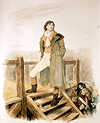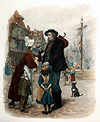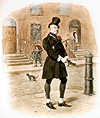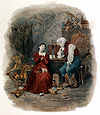| [The
Times, London, Thursday October
1, 1896; p.9; Issue 35010; col D]
(Editor's
Note - Paragraph
breaks added with [p] for readability on the net)
Inquest
Yesterday
afternoon. Mr. A. Braxton
Hicks, the Mid-Surrey coroner, held an inquiry at the local board
offices,
Wimbledon, with reference to the death of Mr. FEDERICK BARNARD,
the
well-known artist in black and white, who was suffocated in a fire
which
occurred on Saturday last at Abermaw, Merton-hall-road, Wimbledon. Mr.
C. W. Langford, solicitor, attended to watch the case on behalf of Mr.
Ambrose Myall, a gentleman interested.
Mrs.
Alice Barnard, of Wemman-house, Wenman-road, Hampstead, said the
deceased
was her husband, from whom she was separated. [p]
He was 50
years of age. [p]
She spent
a few days in the country
with him quite recently, and he was then in his usual good health. She
was aware that he was fond of smoking in bed, and that he suffered from
sleeplessness. He was accustomed to take a drug, the medicinal quality
of which was of a hypnotic nature; otherwise he was of very steady
habits.
He had been engaged in his work right up to the last, and was in no way
incapacitated by the use of the drug. There was nothing else that the
witness
wished to add. [p]
Mrs.
Annie Laura Myall, wife of Mr.
Ambroso Augustus Myall, said she resided at Abermaw,, Merton-hall-road,
but not with her husband. The deceased had been lodging with her for
nearly
four months, occupying the back bedroom on the first floor. He did his
work in London. During the time he had been living there she had smelt
smoke in his bedroom, but she did not know that he was given to smoking
in bed. When he came to her she thought he looked old, and that he
seemed
feeble for a man of his age; in fact she was under the impression that
he was at least 60. He did not appear to be in good health, but she was
not aware that he took sleeping draughts. She never saw him otherwise
than
perfectly sober, and he always kept good hours. [p]
On
Saturday night he went to bed as
usual at 10 o'clock and she heard nothing during the night. It was his
custom to lie in bed until a late hour on Sunday. Witness had not
noticed
any smell of burning in his room, but her servant, Mary Tritt, did.
This
was at 10 o'clock on Sunday morning, and she told witness that she had
shut her bedroom window in consequence. She remarked that she thought
some
one was burning weeds in the garden, and no further notice was taken of
the matter. [p]
Later on
Mrs. Friswell, witness's mother,
came and told her that she thought she heard a noise in Mr.s Barnard's
room, and she knocked at the doorand asked him whether she could do
anything
for him, and that Mr. Barnard replied, "No, Madam, no." [p]
At
half-past 1 Miss Gaubert, a neighbor,
came to the house and said she had seen smoke coming from the
deceased's
bedroom window. Witness rushed upstairs, after sending her little boy
for
assistance, and upon opening the door found the room full of smoke,
which
was so dense that she could not see anything in the room. Mrs. Friswell
followed her up, seizing a jug of water, and threw it into the room.
Directly
the door was opened she saw a short flame flare up on the further side
of the bed. Her mother threw the water over the fire and witness said,
"Where is Mr. Barnard?" adding, "He is not here." [p]
Her
mother answered, "Yes he is here,
and I think he is dead." [p]
Witness
could then discern the
dim shadow of his body through the smoke. Mr. Mack, the neighbor who
had
come in, ran as fast as he could for further assistance, and the fire
brigade
shortly afterwards arrived. Meanwhile the fire had been extinguished,
and
when the firemen came they threw the smoldering bed out the window.
When
witness saw the deceased's pipe and matches they had been placed in a
bowel.
[p]
Mrs. Emma
Friswell, mother of the last
witness, said that at 10:30 on Sunday morning she heard the sound of
groaning
proceeding from Mr. Barnard's bedroom, and knocking at the door, she
asked,
"Are you ill? Can I do anything for you?" [p]
He said,
"No madam, no,"" quite clearly.
The witness then corroborated her daughter's evidence as to what
happened
subsequently. It was the corner of the room that was in flames, and she
thought that an ottoman was the seat of the fire. She had seen the
deceased
smoking cigarettes, but not a pipe. The ashes from his pipe might have
fallen on to the ottoman. [p]
Mr.
Robert Ellis Mack, an art editor,
of B(?)eech-hall, Merton-hall-lane, stated that Mr. Barnard was a
personal
friend of his, and so late as Saturday night he finished sketches of
Squire
Thornleigh and Dr. Primrose for a new edition of "The Vicar of
Wakefield."
He was then very jolly. His work was better than ever it had been. [p]
He was
aware that the deceased was
in the habit of reading until 3 or 4 o'clock in the morning, when he
would
fall asleep. He had seen him smoking in bed, and had warned
him of the danger of doing so. He had seen burnt paper which he had
carelessly
thrown down in the room. [p]
Captain
Leach, chief of the Wimbledon
Fire Brigade, deposed to being called to the outbreak and finding the
mattress
smoudering. The deceased was lying on the bed in a natural position.
The
mattress had been burning as a haystack would. Witness found a pipe and
a cigar on the floor near the foot of the bed, and there was some
tobacco
in a pouch on a washstand close by. The pipe might have fallen off the
bed, but cigar had not been lit. [p]
Dr.
Samuel R. Collyer, of Hartfield
Wimbledon, stated that in his opinion the case of the death was
suffocation,
consequent upon the smoke. The coroner said the bedding, being composed
of wool and straw, would account for the intensity of the smoke. In
summing
up the coroner spoke of the deceased's qualities as an artist, and said
there was no question as to his sobriety, his work requiring the
steadiest
of hands. The drug which he had been in the habit of taking was more
neurotic
than narcotic, the deceased no doubt having recourse to it to steady
his
nerves. [p]
The jury
retired and after a quarter
of an hour's deliberation returned into the Court with a verdict of
"Accidental
death." [p]
The
coroner said Mr. Langford wished
it to be known -- although it had nothing to do with the inquiry --
that
the deceased was a stranger to Mr. Ambrose Myall [the gentleman
interested],
who was not aware that he was living at Abermaw. He thought there was
no
question that the deceased was anything else than a lodger there. He
told
the jury that now they had returned their verdict.
|






